The Yucatan molly, commonly known as the giant sailfin molly, is a captivating live-bearing fish belonging to the Poeciliidae family. This species, known for its striking appearance and lively behavior, is an excellent choice for both beginners and experienced aquarists. In the following sections, you will find essential information on keeping, feeding, and breeding the Yucatan molly, along with practical tips to create a thriving environment for these remarkable fish.
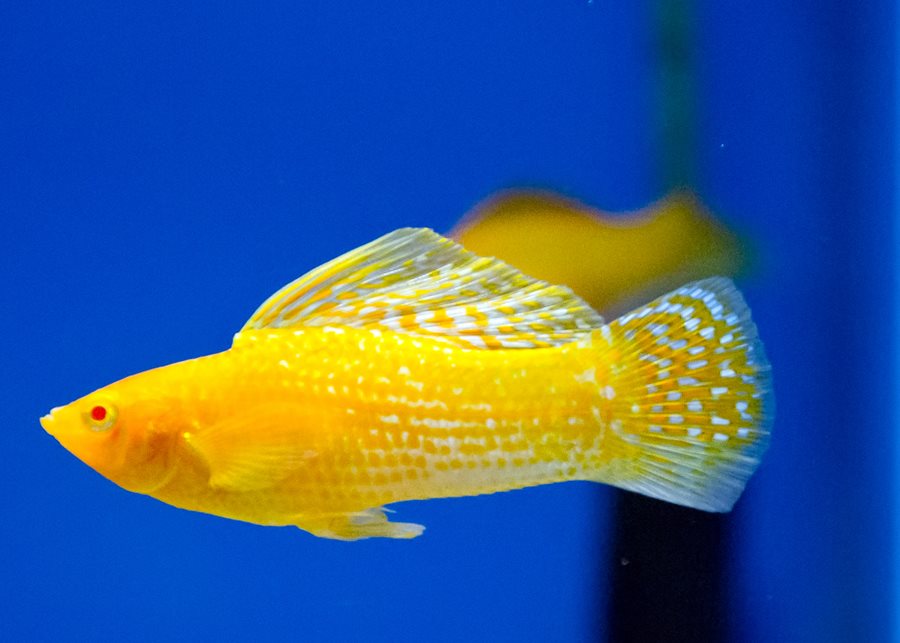
Contents
Habitat in the wild
The Yucatan molly, commonly known as the giant sailfin molly, is a captivating live-bearing fish belonging to the Poeciliidae family. Originally discovered in a small lake on the Yucatan Peninsula in Mexico at the end of the 19th century, the species was brought to Europe in 1913 and was subsequently classified as Mollienesia velifera. Following a revision, it was reclassified into the genus Poecilia, sharing its lineage with the black molly.
This species is typically found in freshwater habitats, including rivers that flow into the Caribbean Sea, as well as estuaries with brackish water. While it was initially endemic to the Yucatan Peninsula, its natural habitat now stretches from Mexico to Colombia. Due to its popularity in home aquariums, the Yucatan molly has been introduced to regions such as the Middle East, Southeast Asia, Australia, and New Zealand, where it has become an invasive species.
Description
Size and Growth
Poecilia velifera is the largest species in the Poeciliidae family. In the wild, it can grow up to 8 inches (20 cm) long. However, in aquariums, their size is generally smaller, with females typically reaching a maximum of 6 inches (15 cm) and males growing up to 4 inches (10 cm). This size difference is primarily due to the constraints of a tank environment compared to their natural habitat.
Related Species
The Yucatan molly has a closely related species, Poecilia latipinna, which is also popular among aquarists. Juveniles of both species have similar appearances and can only be distinguished by the number of rays on their dorsal fins. Poecilia velifera has 18 to 19 rays, while Poecilia latipinna has only 14. Adult fish exhibit more pronounced distinctive features; notably, Poecilia velifera is larger and is often referred to as the giant sailfin molly.
Hybridization and Breeding Effects
Uncontrolled selective breeding has complicated the classification of these fish. Many hybrids have emerged, making it challenging to define specific color variations accurately. Hybridization between Poecilia velifera and Poecilia latipinna is occurring in the wild, while selective breeding in captivity has produced numerous variations with unique forms and colors.
Color Variations
Originally, the Yucatan molly had a gray coloration with a pattern of horizontal lines. Recently, many hybrid variations have been developed, showcasing a wide array of colors and tints. The most sought-after variations include solid yellow, orange, black, and white (albino), as well as several parti-colored options, appealing to diverse aesthetic preferences among aquarists.
| Characteristic | Description |
|---|---|
| Scientific Name | Poecilia velifera |
| Common Name | Yucatan Molly; giant sailfin molly; yellow sailfin molly; molly velifera; velifera fish; harlequin sailfin molly |
| Family | Poeciliidae |
| Origin | Mexico (native to Laguna de Tamiahua and Rio Tamazunchale) |
| Size | Up to 4-5 inches (10-13 cm) |
| Lifespan | 2-3 years (may vary with care) |
| Coloration | Generally greenish, with variations; males may be more colorful |
| Body Shape | Slender and elongated body shape |
| Fin Features | Prominent sail-like dorsal fin in males |
| Behavior | Peaceful, sociable, and active |
| Aquarium Requirements | Freshwater, well-maintained tank with hiding spots |
| Water Parameters | Temperature: 72-82°F (22-28°C), pH: 7.0-8.5 |
| Diet | Omnivorous, eats flakes, pellets, live/frozen foods |
| Breeding | Livebearer, gives birth to fry (live young) |
| Care Level | Moderate, suitable for beginners with proper setup |
| Tank Size | Minimum 20-gallon tank for a small group |
| Compatibility | Peaceful community fish, avoid fin nippers |
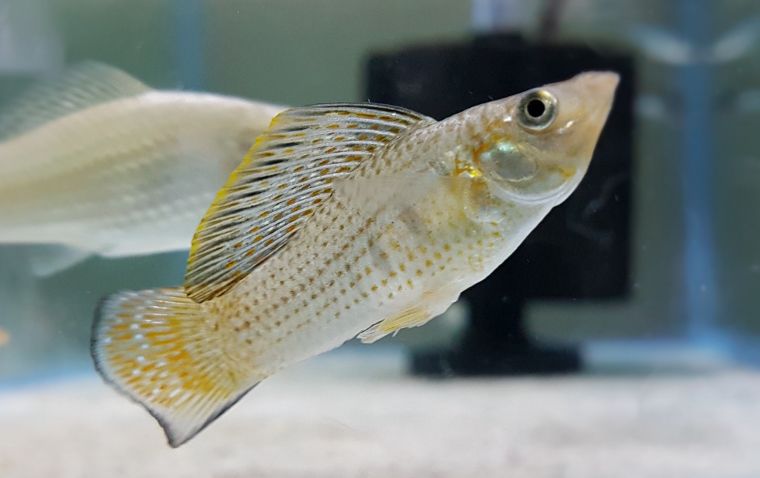
Care and keeping in a tank
Lifespan
With proper care, Poecilia velifera can live for about 5 years in captivity. This species produces good-sized offspring, and the development pace of young fish depends on various factors, including tank conditions and diet. In optimal conditions, Yucatan mollies reach reproductive maturity at 6 to 8 months, which is later than some other live-bearing species. Despite this delayed maturation, their longer lifespan means they remain fertile for a significant portion of their lives. In the wild, similar trends are observed, with fertility typically declining in the last 6 to 12 months of life.
Tank Size
A spacious tank is crucial for the healthy development of Yucatan mollies. In small tanks, they tend to exhibit stunted growth, leading to underdeveloped offspring. To maintain a healthy school of 10 to 12 adult fish, a minimum tank size of 200 liters (52 gallons) is recommended. This size allows for adequate swimming space and encourages social interactions, which are vital for their well-being.
Water Parameters
Regular monitoring of water conditions is essential for keeping Yucatan mollies healthy. A 30% water change should be performed weekly, ensuring that the new water matches the existing parameters. Acceptable water parameters include a pH of 7.0 to 8.8 and a hardness (kH) of 8 to 25°. It is advisable to maintain water at the upper limits of acidity and hardness, as these reflect the fish’s natural habitat. The optimal temperature range is between 22 to 28 °C. However, maintaining a temperature closer to the lower limit can promote better growth and color retention, while high temperatures may lead to smaller sizes, faded coloration, and reduced lifespan.
Some aquarists opt to keep Yucatan mollies in brackish water by using sea salt, but this is not necessary for their care.
Tank Setup: Decorations and Plants
Yucatan mollies produce secretions that benefit tank plants, aiding in biological filtration through microorganisms in the substrate. Suitable tank plants include burhead (Echinodorus) and various types of cryptocorynes, such as Cryptocoryne aponogetifolia, Cryptocoryne pontederiifolia, and Cryptocoryne wendtii var. wendtii.
For foreground plants, smaller Echinodorus species like Echinodorus tenellus and Echinodorus quadricostatus can create a vibrant green lawn. Long-stemmed plants like Limnophila aquatica and certain Bacopa species, particularly Bacopa caroliniana, thrive in the optimal conditions for Yucatan mollies.
While live plants enhance water quality and provide habitat, it is possible to keep Yucatan mollies without them, using large decorative stones, natural or artificial driftwood, and other decorative elements instead. This approach can be effective if water conditions are well-maintained.
Filtration
When selecting a filtration system, opt for filters that create a directed water flow. This artificial current encourages muscular activity and healthy physical development. However, Yucatan mollies are not particularly demanding, and a small internal filter is usually sufficient to maintain a clean and stable environment.
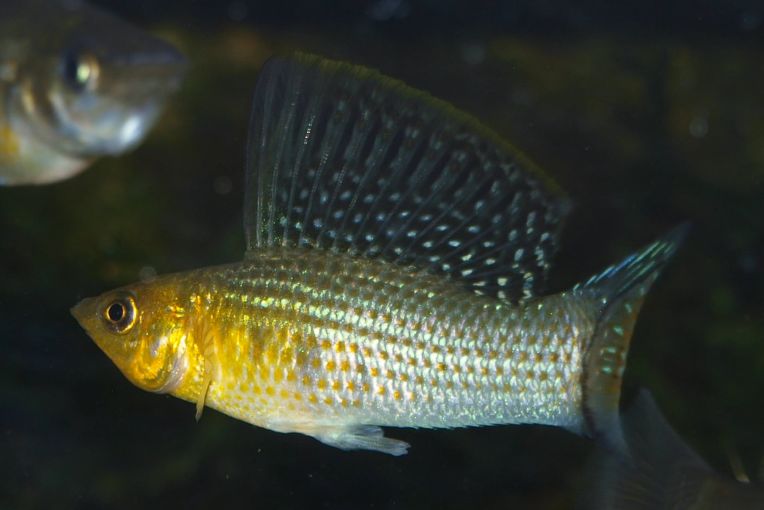
Diet
The giant sailfin molly requires a nutritious and varied diet to thrive. While juveniles can grow well on a range of foods, the dietary needs of adults are more specific and should be carefully selected. A balanced diet for adult giant sailfin mollies includes a mix of protein sources and plant matter to ensure optimal health.
Giant sailfin mollies eagerly consume bloodworms, glassworms, and sludge worms, though the latter requires careful disinfection and appropriate dosing to avoid health issues. Alongside these protein-rich foods, incorporating plant-based options is essential. Many aquarists recommend offering finely cut and parboiled spinach or lettuce leaves, which are beneficial due to their high content of B vitamins and their role in restoring metabolic processes.
The approximate daily food requirement for giant sailfin mollies is about 3% of their body mass. During the active growth phase of juveniles, it is advisable to feed them three times a day. For adult breeders, feeding should occur no more than once or twice daily to prevent overfeeding. Proper food distribution is crucial; overfeeding can disrupt the fish’s weight balance, while underfeeding can lead to undersized fish that lack vitality.
A diverse and balanced diet necessitates constant attention from aquarists. While this process may be time-consuming, utilizing high-quality artificial food can simplify feeding routines. Look for options that contain essential nutrients and have a high dietary fiber content, or choose specialized food formulated for live-bearing fish to meet the specific preferences of the giant sailfin molly.
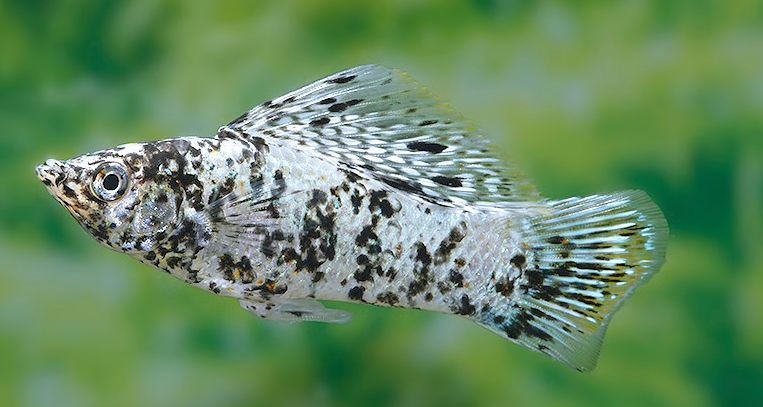
Tank mates
Giant sailfin mollies thrive in small groups rather than forming stable pairs. In these groups, the dominant male typically exhibits little aggression towards other members, reducing the risk of serious injuries often seen in species like swordtails. To create a visually appealing tank, it is advisable to maintain an equal number of males and females. This setup fosters healthy competition among males, which enhances their courtship displays. During these displays, males spread their fins dramatically and swim in circles, while females often appear aloof, swimming aside as if uninterested.
Giant sailfin mollies are compatible with community tanks, making them excellent choices for peaceful environments. They can coexist well with other tranquil species, particularly live-bearing fish, such as guppies or platies.
When selecting tank mates, let them be of a similar size. Mollies get on well with other live-bearing fishes such as (guppy, Endler’s guppy, platy, swordtail), characins (black neon tetra, cardinal tetra, ember tetra, flame tetra, neon tetra), rasboras (harlequin rasbora), danios (zebrafish), corydoras (Corydoras julii, panda cory, pygmy cory, Adolfo’s catfish), plecos (bristlenose pleco). They can live together with barbs (tiger barb, cherry barb, Odessa barb, rosy barb); Poecilia velifera is the only exception – the males’ long fins may be nipped in this case.
When keeping mollies with other fishes, the tank should be spacious, and it should have enough shelters. It’s not recommended to keep even large molly species with aggressive cichlids (like Jack Dempsey fish, jaguar cichlid, texas cichlid, flowerhorn).
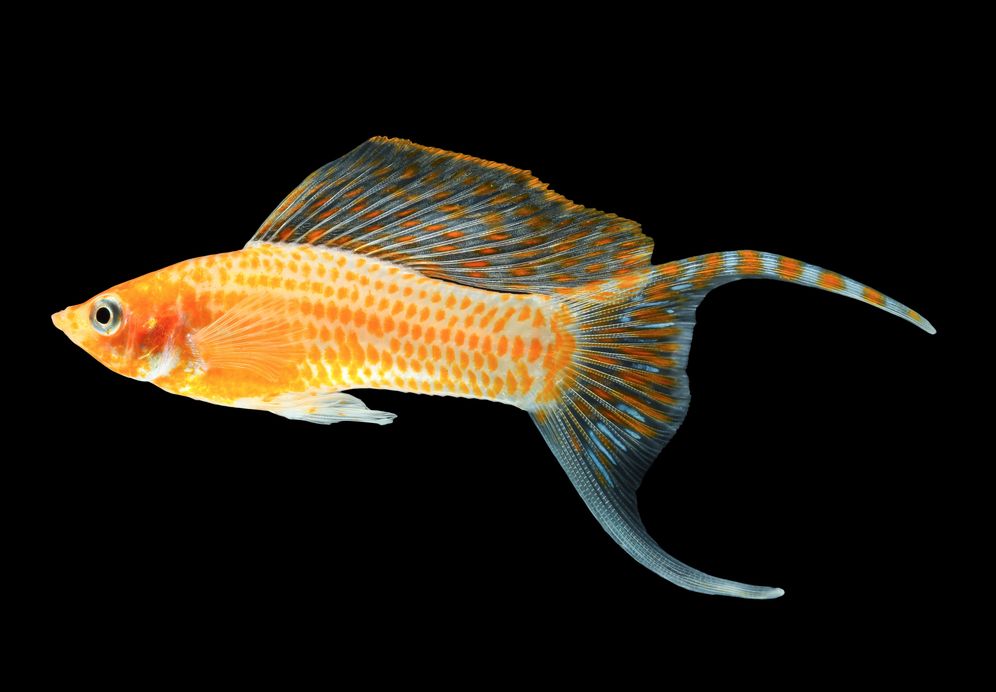
Gender differences: male vs female
The giant sailfin molly exhibits clear sexual dimorphism. Males are generally smaller, slimmer, and more brightly colored than females, which tend to have a larger, fuller body shape and a more subdued coloration. One of the most distinctive features of males is their large, sail-shaped fin, which is absent in females. This difference not only helps in identifying the sexes but also plays a significant role during courtship displays, where the males use their vibrant colors and impressive fins to attract females.
Breeding
Giant sailfin mollies do not form stable pairs and prefer to live in small schools, except during the courtship period. Breeding occurs similarly to other live-bearing fish; after mating, a female gives birth to juveniles that are approximately 6-8 cm long and capable of independent living, with litter sizes typically ranging from 60 to 120 fry. This prolific reproduction makes them an appealing choice for aquarists looking to breed fish.
The best initial food for these fry is brine shrimp nauplii, which provide essential nutrients for healthy growth. Unlike many other live-bearing species, giant sailfin mollies do not consume their young, making it easier to raise the juveniles. However, for optimal growth, it’s advisable to move them to a separate tank, maintaining similar water parameters while gradually increasing the temperature by 2 °C during the first two weeks to encourage faster growth.
Growing the juveniles is straightforward, provided they receive adequate nutrition and proper tank maintenance. This includes renewing 80-100% of the tank water weekly and ensuring continuous filtration. Regular cleaning tasks, such as removing waste, washing filter materials, and cleaning connecting tubes, are essential for maintaining a healthy environment. Poor water quality can lead to stunted growth or disease, so diligent care is crucial.
During their first month, juveniles should be fed 4-6 times a day. Given their poor eyesight, it’s best to distribute food in well-lit areas of the tank to ensure they can find it. The growth rate among juveniles can vary significantly; some fry will develop faster than others. Early identification of the strongest individuals is important, and any with congenital defects, such as spinal curvature or internal issues, should be culled to maintain a healthy population.
Giant sailfin mollies reach reproductive maturity later than many other live-bearing fish, typically at 6-8 months. However, their longer lifespan—often exceeding five years in captivity—compensates for this delay, making them a rewarding addition to any aquarium.
In addition to these breeding and care aspects, it’s noteworthy that giant sailfin mollies are relatively hardy fish that adapt well to a range of water conditions. Their vibrant colors and flowing fins add beauty to community tanks, where they coexist peacefully with other compatible species. Moreover, they thrive in environments enriched with plants, which can provide cover for the juveniles and enhance water quality through natural filtration.